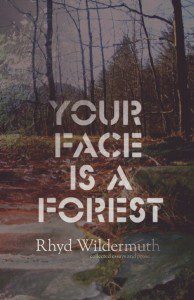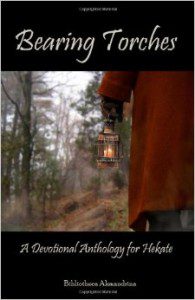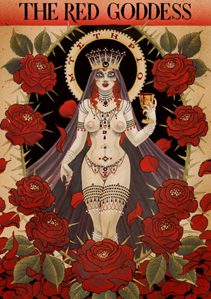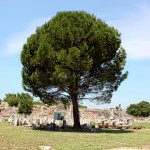Sometimes I read for information. Sometimes I read for fun. But sometimes I read because I need something to get me moving, or to help me figure out which direction to go.
These are the first three books I’ve read this year. None are especially new – Your Face Is A Forest was published in 2014, the others are older. But they were all new to me, and I suspect they may be new to you. I found them mostly helpful – you may also.
I don’t review books differently based on how I get them, but for those who care about such things, I bought all these myself – none were review copies. Some of the writers are friends, but if I couldn’t honestly give these books a good recommendation, I’d simply decline to review them.
 Your Face Is A Forest
Your Face Is A Forest
by Rhyd Wildermuth
published via Lulu, November 2014
Perfect-bound paperback: $16.95
205 pages
This book is a collection of personal experiences, religious experiences, and poetry. It’s the memoir of someone whose life has been unnecessarily and unjustly hard. It’s a work of polytheist and animist theology. It’s a manual for an Earth-centered anarchist revolution.
Let’s be honest – I don’t know what this book is. I just know what it does and how it makes me feel.
“Knight of Cups, Knight of Wands” is Rhyd Wildermuth’s story of coming out as a gay man to his roommate at a conservative Christian college. It was an act demanded by integrity, but one that cost him both a friend and the scholarship that was his only chance for a college degree (though not, as some have recently suggested, his only chance for an education). I had read an earlier version of this story on Rhyd’s blog and it filled me with anger, an anger that was rekindled when I read it again.
It matters what we believe, for what we believe influences how we act, and how we act influences the world – for better, or as in this case, for worse.
“Under The Pavement, The Forest” tells how Rhyd found the Gods and spirits of Nature in an urban park. I used it as the morning reading in the Sunday Service for The Care and Feeding of Activists. It seemed appropriate: Rhyd is an activist, and this story illustrates how someone can be called to activism… and what they might feel a need to be active about.
It also seemed appropriate to use this book in the spot in the order of service where the Christian forebears of Unitarian Universalism would have used a reading from the Bible. Your Face Is A Forest is best read like scripture. Trying to read it literally will frustrate you. It includes historical facts, but it’s not a work of history.
Instead, read it mythically and see what timeless truths you discover. Read it mystically and see what inspiration comes to you.
Just read it.
 Bearing Torches: A Devotional Anthology for Hekate
Bearing Torches: A Devotional Anthology for Hekate
edited by Sannion
published by Bibliotheca Alexandrina, November 2009
trade paperback: $11.69
200 pages
This is another devotional anthology dedicated to a specific deity. Like the anthologies to Cernunnos (Hoofprints in the Wildwood, 2011) and Morrigan (By Blood, Bone, and Blade, 2014) it’s a mixture of academic works, poems, fiction, and personal accounts of experience and devotion. If you’ve read my reviews of those books you know that while I recommend them, they’re rather uneven: some of the entries are very good, some are derivative, and some are just puzzling.
Not so with Bearing Torches. While the approach and emphasis varies from piece to piece, all of them are very good. Perhaps this is because there’s so much more material about the Hellenic deities from antiquity than about the Celtic deities. Perhaps the contributions were more tightly screened and edited. Perhaps Hekate Herself took a larger role in creating this book. I don’t know – I just know it’s quite good.
I’m not well-acquainted with Hekate. I know a bit about Her historically, and Denton CUUPS has honored Her in ritual a time or two, though not recently. Reading Bearing Torches left me with a greater appreciation of Her complexity and depth, but I don’t expect to be called by or to Her… though I’ve learned to never say never when dealing with the Gods.
The value of this book to me is in how it shows what’s possible: what good devotion looks like, what good sacrifice looks like, and perhaps most importantly, how all that can be done in a context that bears little resemblance to Wicca and classical occultism. There’s nothing wrong with Wicca and classical occultism (they’ve influenced my own practices, and mostly for the good), but they’re not the only way to do Paganism.
If you have an interest in Hekate or the other deities of ancient Greece, or if you just want to see what good polytheist devotion looks like, read Bearing Torches.
 The Red Goddess
The Red Goddess
by Peter Grey
published by Scarlet Imprint, 2007
trade paperback: £16 (with currency conversion and shipping, my copy was $29.29)
248 pages
Peter Grey is impossible to ignore. His Rewilding Witchcraft essay from last June has been quoted numerous times on Pagan blogs and other sites. In it he says
How tame we have become. How polite about our witchcraft. In our desire to harm none we have become harmless.
and
We are not simply losing it all, it is being stripped from us as surely as those accused of being witches were by their inquisitors in the torture cell. Our enemies are not our sisters and brothers in the craft, they are the named individuals and corporations and their governments who are tearing out our living flesh. Witchcraft has never been about turning the other cheek to this. The witch has been created by the land to speak and act for it.
Grey’s book Apocalyptic Witchcraft explores this theme in greater depth, making a strong case that modern Western society is irreparably broken and that witchcraft is the only cure. I found it both challenging and inspiring.
And so when I felt the need for more inspiration, I picked up Grey’s older book The Red Goddess. I knew it wouldn’t be more of the same, but I didn’t need more of the same – I just needed a metaphysical jolt.
The Red Goddess is a history of Babalon,
a Goddess risen from the rich biblical vision of Revelation. A Goddess who apparently appeared from nowhere, with a seven-headed Beast in attendance, giving Christian kids compelling sexy nightmares about the impending war in heaven.
The first quarter of the book is a historical and literary investigation of who Babalon is and isn’t. The middle half looks at famous occultists who attempted to work with Babalon, with varying degrees of success: Simon Magus, John Dee, Aleister Crowley, and Jack Parsons. The final quarter is a description of how – and why – we can work with Babalon today.
Whatever and whoever else Babalon may be, She is the holy whore, the temple prostitute, the embodiment of sacred sexuality. She is the birthright that has been stolen by the Abrahamic religions and their disgust with the human body – and their fear of the female body. Reclaiming that sacred sexuality has been a key point of modern Paganism since at least the early 20th century.
This is a book intended to wake the reader with the shock of a 150 decibel alarm clock. And perhaps, if an orthodox monotheist were to read it honestly and openly, it might give them the motivation to re-evaluate their religion and their lives. But for Pagans, it strikes me as a book that wouldn’t have been shocking in 1967, much less when it was written in 2007. I found it interesting and even educational, but a long way from challenging and inspiring.
The Red Goddess is an excellent book, but it isn’t the book I was looking for.

















